Impact of Sea Breeze on the Transport of Ship Emissions: A Comprehensive Study in the Bohai Rim Region, China
Abstract
1. Introduction
2. Methodology
2.1. Study Area
2.2. Input Data and Model Configuration
2.2.1. Input Data
2.2.2. Model Configuration
2.3. Model Evaluation
2.4. Identification of Onshore Wind
2.5. Identification of the Sea Breeze
3. Results
3.1. Contribution of Ship Emissions to Concentration of PM2.5
3.2. The Reinforcing Effect of Onshore Wind on the Transport of Ship Emissions
3.3. Impact of Sea Breeze on the Transport of Ship Emissions
4. Conclusions
Author Contributions
Funding
Institutional Review Board Statement
Informed Consent Statement
Data Availability Statement
Acknowledgments
Conflicts of Interest
References
- Bie, S.; Yang, L.; Zhang, Y.; Huang, Q.; Li, J.; Zhao, T.; Zhang, X.; Wang, P.; Wang, W. Source appointment of PM2.5 in Qingdao Port, East of China. Sci. Total Environ. 2021, 755, 142456. [Google Scholar] [CrossRef] [PubMed]
- Corbett, J.J.; Fischbeck, P. Emissions from Ships. Science 1997, 278, 823–824. [Google Scholar] [CrossRef]
- Endresen, Ø.; Sørgård, E.; Sundet, J.K.; Dalsøren, S.B.; Isaksen, I.S.A.; Berglen, T.F.; Gravir, G. Emission from international sea transportation and environmental impact. J. Geophys. Res. Atmos. 2003, 108, 4560. [Google Scholar] [CrossRef]
- Lv, Z.; Liu, H.; Ying, Q.; Fu, M.; Meng, Z.; Wang, Y.; Wei, W.; Gong, H.; He, K. Impacts of shipping emissions on PM2.5 pollution in China. Atmos. Chem. Phys. 2018, 18, 15811–15824. [Google Scholar] [CrossRef]
- Ramacher, M.O.P.; Tang, L.; Moldanova, J.; Matthias, V.; Karl, M.; Fridell, E.; Johansson, L. The impact of ship emissions on air quality and human health in the Gothenburg area—Part II: Scenarios for 2040. Atmos. Chem. Phys. 2020, 20, 10667–10686. [Google Scholar] [CrossRef]
- Sorte, S.; Rodrigues, V.; Borrego, C.; Monteiro, A. Impact of harbour activities on local air quality: A review. Environ. Pollut. 2020, 257, 113542. [Google Scholar] [CrossRef]
- Ministry of Ecology and Environmental of the People’s Republic. Available online: http://www.mee.gov.cn/hjzl/sthjzk/ydyhjgl/201806/P020180604354753261746.pdf (accessed on 25 April 2022).
- Ministry of Ecology and Environmental of the People’s Republic. Ecological and Environmental Bulletin. Available online: http://www.mee.gov.cn/hjzl/ (accessed on 25 April 2022).
- Camps, J.; Massons, J.; Soler, M.R.; Nickerson, E.C. Pollutant transport in coastal areas with and without background wind. Ann. Geophys. 1997, 15, 476–486. [Google Scholar] [CrossRef]
- Xu, J.; Jia, H.; Zhou, H.; Kang, Y.; Zhong, K. Influences of offshore background wind on the formation of sea-land breeze and the characteristics of pollutant diffusion. Environ. Sci. Pollut. Res. 2021, 28, 68318–68329. [Google Scholar] [CrossRef]
- Yang, Z.Z.; Zhang, X.F.; Bao, X.J.; Chen, S.Y. Numerical Simulation and Analysis of Characteristics of Atmospheric Diffusion in Coastal Area of a Site. In Proceedings of the International Symposium on Resource Exploration and Environmental Science, Ordos, China, 14–16 April 2017. [Google Scholar]
- Zhou, H.; Xie, Y.; Ni, Y.; Shi, Y.; Huang, S. Diffusion acid pollutant driven by wind wave in coastal area. Mar. Environ. Sci. 2012, 31, 16–19. [Google Scholar]
- Chen, D.S.; Tian, X.L.; Lang, J.L.; Zhou, Y.; Li, Y.; Guo, X.R.; Wang, W.L.; Liu, B. The impact of ship emissions on PM2.5 and the deposition of nitrogen and sulfur in Yangtze River Delta, China. Sci. Total Environ. 2019, 649, 1609–1619. [Google Scholar] [CrossRef]
- Chen, D.S.; Liang, D.Y.; Li, L.; Guo, X.R.; Lang, J.L.; Zhou, Y. The Temporal and Spatial Changes of Ship-Contributed PM2.5 Due to the Inter-Annual Meteorological Variation in Yangtze River Delta, China. Atmosphere 2021, 12, 722. [Google Scholar] [CrossRef]
- Chen, D.S.; Zhang, Y.; Lang, J.L.; Zhou, Y.; Li, Y.; Guo, X.R.; Wang, W.L.; Liu, B. Evaluation of di erent control measures in 2014 to mitigate the impact of ship emissions on air quality in the Pearl River Delta, China. Atmos. Environ. 2019, 216, 116911. [Google Scholar] [CrossRef]
- Chen, D.S.; Fu, X.Y.; Guo, X.R.; Lang, J.L.; Zhou, Y.; Li, Y.; Liu, B.; Wang, W.L. The impact of ship emissions on nitrogen and sulfur deposition in China. Sci. Total Environ. 2020, 708, 124636. [Google Scholar] [CrossRef] [PubMed]
- Liu, Z.; Lu, X.; Feng, J.; Fan, Q.; Zhang, Y.; Yang, X. Influence of Ship Emissions on Urban Air Quality: A Comprehensive Study Using Highly Time-Resolved Online Measurements and Numerical Simulation in Shanghai. Environ. Sci. Technol. 2017, 51, 202–211. [Google Scholar] [CrossRef]
- Hawkins, J.D. Study of the Mesoscale Wind Circulation in a Land-Sea Breeze Regime. Bull. Am. Meteorol. Soc. 1977, 58, 1289–1295. [Google Scholar] [CrossRef][Green Version]
- Kozo, T.L. An Observational Study of Sea Breezes along the Alaskan Beaufort Sea Coast: Part I. J. Appl. Meteorol. 1982, 21, 891–905. [Google Scholar] [CrossRef][Green Version]
- Han, S.Q.; Cai, Z.Y.; Liu, J.L.; Zhang, M.; Chen, J.; Lin, Y. Comparison on aerosol physicochemical properties of sea and land along the coast of Bohai, China. Sci. Total Environ. 2019, 673, 148–156. [Google Scholar] [CrossRef]
- Huang, M.; Gao, Z.; Miao, S.; Xu, X. Characteristics of sea breezes over the Jiangsu coastal area, China. Int. J. Climatol. 2016, 36, 3908–3916. [Google Scholar] [CrossRef]
- Zhang, Z.Z.; Cao, C.X.; Song, Y.; Kang, L.; Cai, X.H. Statistical Characteristics and Numerical Simulation of Sea-Land Breezes in Hainan Island. J. Trop. Meteorol. 2014, 20, 267–278. [Google Scholar]
- Lu, X.; Chow, K.-C.; Yao, T.; Fung, J.C.H.; Lau, A.K.H. Seasonal variation of the land-sea breeze circulation in the Pearl River Delta region. J. Geophys. Res. Atmos. 2009, 114, D17. [Google Scholar] [CrossRef]
- Zhao, D.; Xin, J.; Wang, W.; Jia, D.; Wang, Z.; Xiao, H.; Liu, C.; Zhou, J.; Tong, L.; Ma, Y.; et al. Effects of the sea-land breeze on coastal ozone pollution in the Yangtze River Delta, China. Sci. Total Environ. 2021, 807, 150306. [Google Scholar] [CrossRef] [PubMed]
- Pokhrel, R.; Lee, H. Estimation of the effective zone of sea/land breeze in a coastal area. Atmos. Pollut. Res. 2011, 2, 106–115. [Google Scholar] [CrossRef]
- Kitada, T.; Sofyan, A.; Kurata, G. Numerical Simulation of Air Pollution Transport under Sea/Land Breeze Situation in Jakarta, Indonesia in Dry Season. In Air Pollution Modeling and Its Application XIX. NATO Science for Peace and Security Series Series C: Environmental Security; Borrego, C., Miranda, A.I., Eds.; Springer: Dordrecht, The Netherlands, 2008; pp. 243–251. [Google Scholar]
- Kitada, T. Turbulence structure of sea breeze front and its implication in air pollution transport? Application of k-? turbulence model? Bound. Layer Meteorol. 1987, 41, 217–239. [Google Scholar] [CrossRef]
- Liu, J.X.; Song, X.Q.; Long, W.R.; Fu, Y.Y.; Yun, L.; Zhang, M.D. Structure Analysis of the Sea Breeze Based on Doppler Lidar and Its Impact on Pollutants. Remote Sens. 2022, 14, 324. [Google Scholar] [CrossRef]
- Lin, C.Y.; Sheng, Y.F.; Chen, W.C.; Chou, C.C.K.; Chien, Y.Y.; Chen, W.M. Air quality deterioration episode associated with a typhoon over the complex topographic environment in central Taiwan. Atmos. Chem. Phys. 2021, 21, 16893–16910. [Google Scholar] [CrossRef]
- Colbeck, I.; Chung, M.-C.; Eleftheriadis, K. Formation and Transport of Atmospheric Aerosol over Athens, Greece. Water Air Soil Pollut. Focus 2002, 2, 223–235. [Google Scholar] [CrossRef]
- Nie, X.L.; Mao, H.T.; Li, P.Y.; Li, T.; Zhou, J.; Wu, Y.; Yang, M.M.; Zhen, J.B.; Wang, X.L.; Wang, Y. Total gaseous mercury in a coastal city (Qingdao, China): Influence of sea-land breeze and regional transport. Atmos. Environ. 2020, 235, 117633. [Google Scholar] [CrossRef]
- Oh, I.B.; Kim, Y.K.; Lee, H.W.; Kim, C.H. An observational and numerical study of the effects of the late sea breeze on ozone distributions in the Busan metropolitan area, Korea. Atmos. Environ. 2006, 40, 1284–1298. [Google Scholar] [CrossRef]
- Miller, S.T.K.; Keim, B.D.; Talbot, R.W.; Mao, H. Sea breeze: Structure, forecasting, and impacts. Rev. Geophys. 2003, 41, 31. [Google Scholar] [CrossRef]
- Cheng, W.L. Ozone distribution in coastal central Taiwan under sea-breeze conditions. Atmospheric Environ. 2002, 36, 3445–3459. [Google Scholar] [CrossRef]
- Kambezidis, H.D.; Weidauer, D.; Melas, D.; Ulbricht, M. Air quality in the Athens basin during sea breeze and non-sea breeze days using laser-remote-sensing technique. Atmos. Environ. 1998, 32, 2173–2182. [Google Scholar] [CrossRef]
- Maalej, A.; Suhre, K.; Rosset, R. Numerical Analysis of the ROLE of Sea-Breeze Fronts on Air Quality in Coastal and Inland Polluted Areas of Sfax (Tunisia) Sfax; WIT Press: Ashurst, UK, 1997. [Google Scholar]
- Shang, F.; Chen, D.; Guo, X.; Lang, J.; Zhou, Y.; Li, Y.; Fu, X. Impact of Sea Breeze Circulation on the Transport of Ship Emissions in Tangshan Port, China. Atmosphere 2019, 10, 723. [Google Scholar] [CrossRef]
- World Shipping Council. Available online: https://www.worldshipping.org/ (accessed on 25 April 2022).
- Available online: http://www.gov.cn/gzdt/2007-07/20/content_691642.htm (accessed on 25 April 2022).
- Chen, D.S.; Wang, X.T.; Li, Y.; Lang, J.L.; Zhou, Y.; Guo, X.R.; Zhao, Y. High-spatiotemporal-resolution ship emission inventory of China based on AIS data in 2014. Sci. Total Environ. 2017, 609, 776–787. [Google Scholar] [CrossRef] [PubMed]
- Liu, F.; Zhang, Q.; Tong, D.; Zheng, B.; Li, M.; Huo, H.; He, K.B. High-resolution inventory of technologies, activities, and emissions of coal-fired power plants in China from 1990 to 2010. Atmos. Chem. Phys. 2015, 15, 13299–13317. [Google Scholar] [CrossRef]
- Zheng, B.; Huo, H.; Zhang, Q.; Yao, Z.L.; Wang, X.T.; Yang, X.F.; Liu, H.; He, K.B. High-resolution mapping of vehicle emissions in China in 2008. Atmos. Chem. Phys. 2014, 14, 9787–9805. [Google Scholar] [CrossRef]
- Li, M.; Zhang, Q.; Streets, D.G.; He, K.B.; Cheng, Y.F.; Emmons, L.K.; Huo, H.; Kang, S.C.; Lu, Z.; Shao, M.; et al. Mapping Asian anthropogenic emissions of non-methane volatile organic compounds to multiple chemical mechanisms. Atmos. Chem. Phys. 2014, 14, 5617–5638. [Google Scholar] [CrossRef]
- Zhang, Q.; Streets, D.G.; Carmichael, G.R.; He, K.B.; Huo, H.; Kannari, A.; Klimont, Z.; Park, I.S.; Reddy, S.; Fu, J.S.; et al. Asian emissions in 2006 for the NASA INTEX-B mission. Atmos. Chem. Phys. 2009, 9, 5131–5153. [Google Scholar] [CrossRef]
- Zhou, Y.; Xing, X.; Lang, J.; Chen, D.; Cheng, S.; Wei, L.; Wei, X.; Liu, C. A comprehensive biomass burning emission inventory with high spatial and temporal resolution in China. Atmos. Chem. Phys. Discuss. 2017, 2839–2864. [Google Scholar] [CrossRef]
- NCAR. Available online: https://www2.acom.ucar.edu/wrf-chem/wrf-chem-tools-community#download/ (accessed on 19 May 2022).
- NCEP. Available online: https://rda.ucar.edu/datasets/ds083.2/ (accessed on 12 February 2020).
- You, C.; Chi-Hung Fung, J. Characteristics of the Sea-Breeze Circulation in the Pearl River Delta Region and Its Dynamical Diagnosis. J. Appl. Meteorol. Clim. 2019, 58, 741–755. [Google Scholar] [CrossRef]
- Stockwell, W.R.; Middleton, P.; Chang, J.S.; Tang, X.Y. The second generation regional acid deposition model chemical mechanism for regional air quality modeling. J. Geophys. Res. Atmos. 1990, 95, 16343–16367. [Google Scholar] [CrossRef]
- Ackermann, I.J.; Hass, H.; Memmesheimer, M.; Ebel, A.; Binkowski, F.S.; Shankar, U. Modal aerosol dynamics model for Europe: Development and first applications. Atmos. Environ. 1998, 32, 2981–2999. [Google Scholar] [CrossRef]
- Hong, S.-Y.; Noh, Y.; Dudhia, J. A new vertical diffusion package with an explicit treatment of entrainment processes. Mon. Weather Rev. 2006, 134, 2318–2341. [Google Scholar] [CrossRef]
- Fels, S.B.; Schwarzkopf, M.D. An efficient, accurate algorithm for calculating CO2 15 μm band cooling rates. J. Geophys. Res. 1981, 86, 1205–1232. [Google Scholar] [CrossRef]
- Chou, M.S.; Suarez, M.J. A solar radiation parameterization for atmospheric studies. NASA Tech. Memo. 1995, 15, 40. [Google Scholar]
- Lin, Y.F.; Farley, R.D.; Orville, H. Bulk Parameterization of the snow field in a cloud model. Clim. Appl. Meteorol. 1983, 22, 1065–1092. [Google Scholar] [CrossRef]
- Ek, M.B.; Mitchell, K.E.; Lin, Y.; Rogers, E.; Grunmann, P.; Koren, V.; Gayno, G.; Tarpley, J.D. Implementation of Noah land surface model advances in the National Centers for Environmental Prediction operational mesoscale Eta model. J. Geophys. Res. Atmos. 2003, 108, 8851. [Google Scholar] [CrossRef]
- Chen, D.S.; Zhao, N.; Lang, J.L.; Zhou, Y.; Wang, X.T.; Li, Y.; Zhao, Y.H.; Guo, X.R. Contribution of ship emissions to the concentration of PM2.5: A comprehensive study using AIS data and WRF/Chem model in Bohai Rim Region, China. Sci. Total Environ. 2018, 610–611, 1476–1486. [Google Scholar] [CrossRef]
- Xu, Z.; Liu, M.; Zhang, M.; Song, Y.; Wang, S.; Zhang, L.; Xu, T.; Wang, T.; Yan, C.; Zhou, T.; et al. High efficiency of livestock ammonia emission controls in alleviating particulate nitrate during a severe winter haze episode in northern China. Atmos. Chem. Phys. 2019, 19, 5605–5613. [Google Scholar] [CrossRef]
- Liu, M.; Huang, X.; Song, Y.; Xu, T.; Wang, S.; Wu, Z.; Hu, M.; Zhang, L.; Zhang, Q.; Pan, Y.; et al. Rapid SO2 emission reductions significantly increase tropospheric ammonia concentrations over the North China Plain. Atmos. Chem. Phys. 2018, 18, 17933–17943. [Google Scholar] [CrossRef]
- Yao, H.; Song, Y.; Liu, M.; Archer-Nicholls, S.; Lowe, D.; Mcfiggans, G.; Xu, T.; Du, P.; Li, J.; Wu, Y.; et al. Direct radiative effect of carbonaceous aerosols from crop residue burning during the summer harvest season in East China. Atmos. Chem. Phys. 2017, 17, 5205–5219. [Google Scholar] [CrossRef]
- Liu, L.; Huang, X.; Ding, A.; Fu, C. Dust-induced radiative feedbacks in north China: A dust storm episode modeling study using WRF-Chem. Atmos. Environ. 2016, 129, 43–54. [Google Scholar] [CrossRef]
- Gao, M.; Carmichael, G.R.; Saide, P.E.; Lu, Z.; Yu, M.; Streets, D.G.; Wang, Z. Response of winter fine particulate matter concentrations to emission and meteorology changes in North China. Atmos. Chem. Phys. 2016, 16, 11837–11851. [Google Scholar] [CrossRef]
- NCEI. Available online: https://gis.ncdc.noaa.gov/maps/ncei/cdo/hourly/ (accessed on 20 July 2020).
- Boylan, J.W.; Russell, A.G. PM and light extinction model performance metrics, goals, and criteria for three-dimensional air quality models. Atmos. Environ. 2006, 40, 4946–4959. [Google Scholar] [CrossRef]
- Fu, M.; Ding, Y.; Ge, Y.; Yu, L.; Yin, H.; Ye, W.; Liang, B. Real-world emissions of inland ships on the Grand Canal, China. Atmos. Environ. 2013, 81, 222–229. [Google Scholar] [CrossRef]
- Sethuraman, S.; Raynor, G.S. Comparison of Mean Wind Speeds and Turbulence at a Coastal Site and an Offshore Location—Reply. J. Appl. Meteorol. Clim. 1981, 20, 838–839. [Google Scholar] [CrossRef][Green Version]
- Papanastasiou, D.K.; Melas, D. Climatology and impact on air quality of sea breeze in an urban coastal environment. Int. J. Climatol. 2009, 29, 305–315. [Google Scholar] [CrossRef]
- Borne, K.; Chen, D.; Nunez, M. A method for finding sea breeze days under stable synoptic conditions and its application to the Swedish West Coast. Int. J. Climatol. 1998, 18, 901–914. [Google Scholar] [CrossRef]
- Azorin-Molina, C.; Tijm, S.; Chen, D. Development of selection algorithms and databases for sea breeze studies. Theor. Appl. Climatol. 2011, 106, 531–546. [Google Scholar] [CrossRef]
- Furberg, M.; Steyn, D.G.; Baldi, M. The climatology of sea breezes on Sardinia. Int. J. Climatol. 2002, 22, 917–932. [Google Scholar] [CrossRef]
- Prtenjak, M.T.; Grisogono, B. Sea/land breeze climatological characteristics along the northern Croatian Adriatic coast. Arch. Meteorol. Geophys. Bioclimatol. Ser. B 2007, 90, 201–215. [Google Scholar] [CrossRef]
- Saaroni, H.; Maza, E.; Ziv, B. Summer sea breeze, under suppressive synoptic forcing, in a hyper-arid city: Eilat, Israel. Clim. Res. 2004, 26, 213–220. [Google Scholar] [CrossRef]
- Gilliam, R.C.; Raman, S.; Niyogi, D.D.S. Observational and numerical study on the influence of large-scale flow direction and coastline shape on sea-breeze evolution. Bound. Layer Meteorol. 2004, 111, 275–300. [Google Scholar] [CrossRef]
- Arritt, R.W. Numerical modelling of the offshore extent of sea breezes. Q. J. R. Meteorol. Soc. 1989, 115, 547–570. [Google Scholar] [CrossRef]
- Yin, S.Q.; Chen, D.L.; Xie, Y. Diurnal variations of precipitation during the warm season over China. Int. J. Climatol. 2009, 29, 1154–1170. [Google Scholar] [CrossRef]
- Bouchlaghem, K.; Nsom, B.; Lattrache, N.; Haj, H. Characterization of sea breezes and their effects on Air Pollution in the Tunisian Mediterranean region. New Asp. Eng. Mech. Struct. Eng. Geol. 2008, 4, 475–486. [Google Scholar]
- Eager, R.E.; Raman, S.; Wootten, A.; Westphal, D.L.; Reid, J.S.; Al Mandoos, A. A climatological study of the sea and land breezes in the Arabian Gulf region. J Geophys. Res. Atmos. 2008, 113, D15. [Google Scholar] [CrossRef]
- Grønås, S.; Sandvik, A.D. Numerical simulations of sea and land breezes at high latitudes. Tellus A Dyn. Meteorol. Oceanogr. 2016, 50, 468–489. [Google Scholar] [CrossRef][Green Version]
- Prtenjak, M.T.; Viher, M.; Jurkovic, J. Sea-land breeze development during a summer bora event along the north-eastern Adriatic coast. Q. J. R. Meteorol. Soc. 2010, 136, 1554–1571. [Google Scholar] [CrossRef]
- Rani, S.I.; Ramachandran, R.; Subrahamanyam, D.B.; Alappattu, D.P.; Kunhikrishnan, P.K. Characterization of sea/land breeze circulation along the west coast of Indian sub-continent during pre-monsoon season. Atmos. Res. 2010, 95, 367–378. [Google Scholar] [CrossRef]
- Wang, Y.; Di Sabatino, S.; Martilli, A.; Li, Y.; Wong, M.S.; Gutierrez, E.; Chan, P.W. Impact of land surface heterogeneity on urban heat island circulation and sea-land breeze circulation in Hong Kong. J. Geophys. Res. Atmos. 2017, 122, 4332–4352. [Google Scholar] [CrossRef]
- Ji, H.E.; Lee, S.H.; Lee, H.W. Characteristics of sea breeze front development with various synoptic conditions and its impact on lower troposphere ozone formation. Adv. Atmos. Sci. 2013, 30, 1461–1478. [Google Scholar] [CrossRef]
- Levy, I.; Mahrer, Y.; Dayan, U. Coastal and synoptic recirculation affecting air pollutants dispersion: A numerical study. Atmos. Environ. 2009, 43, 1991–1999. [Google Scholar] [CrossRef]

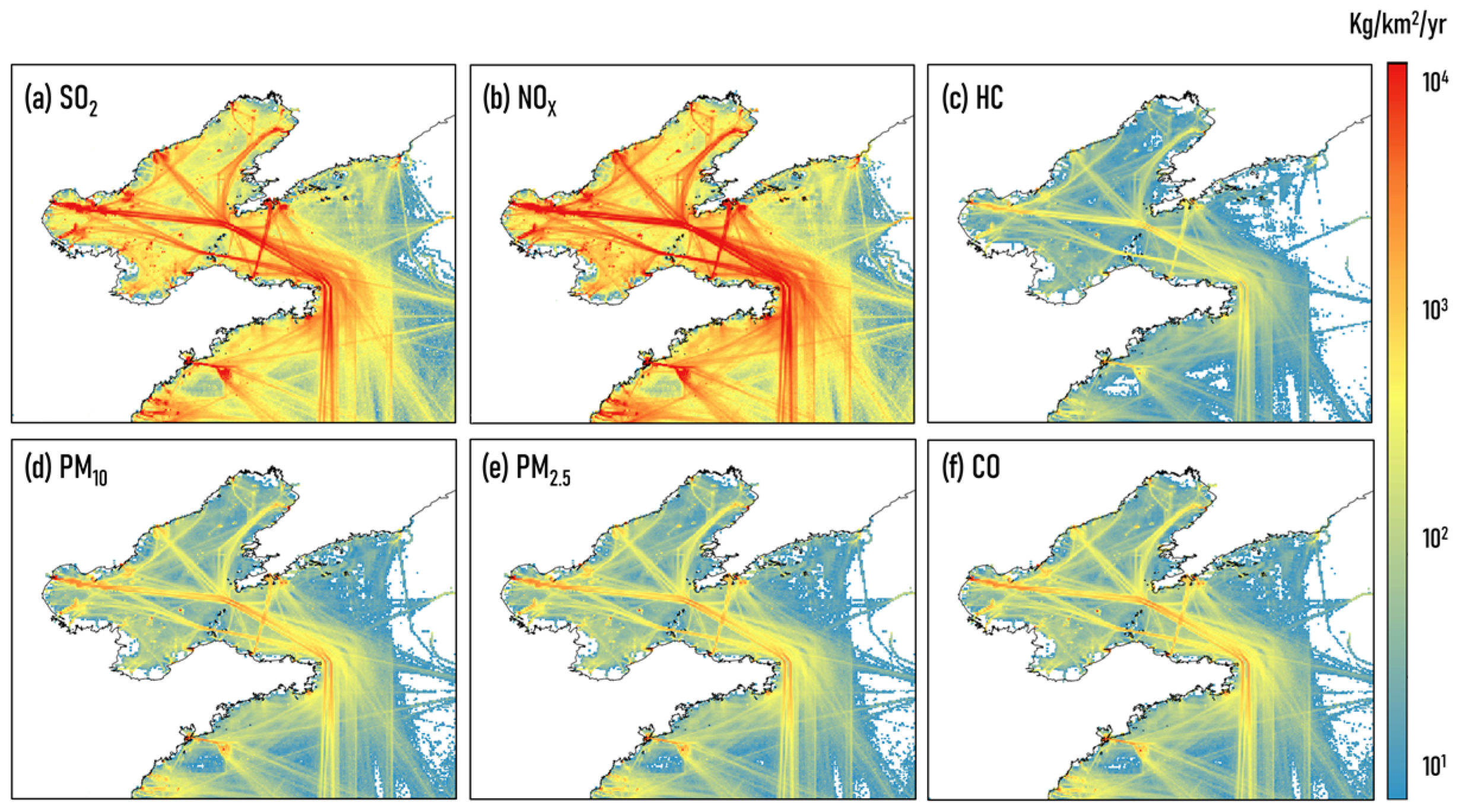
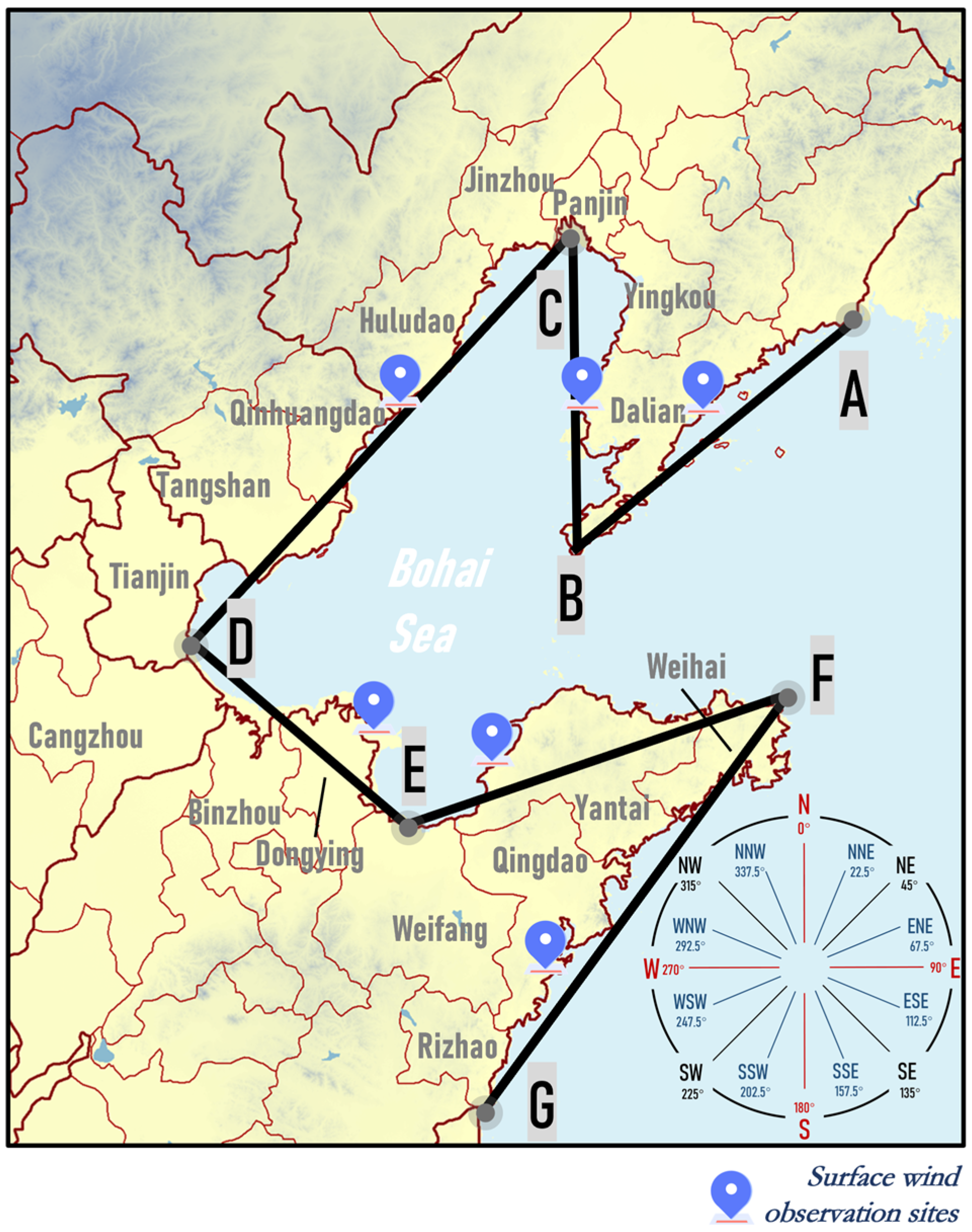
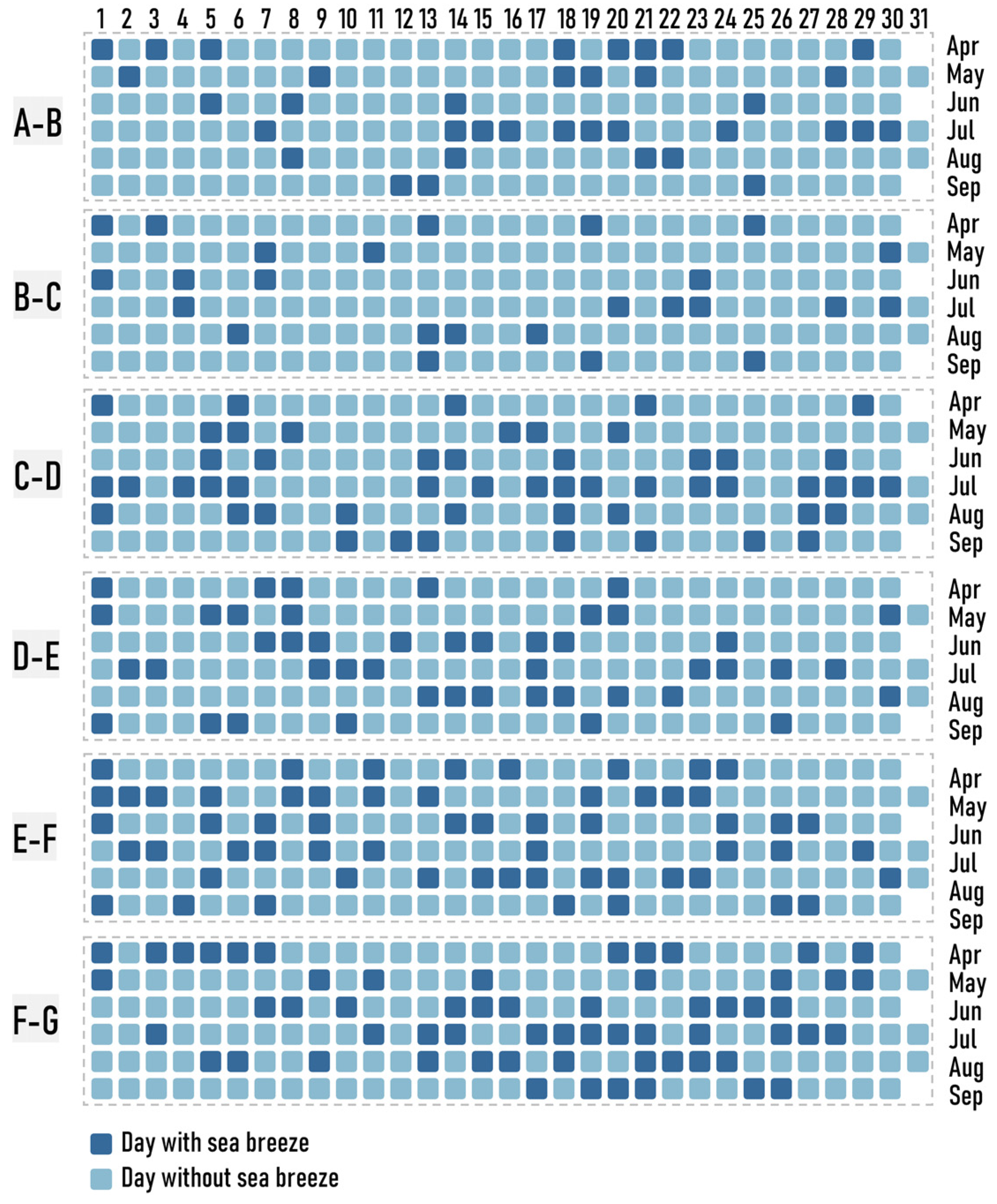
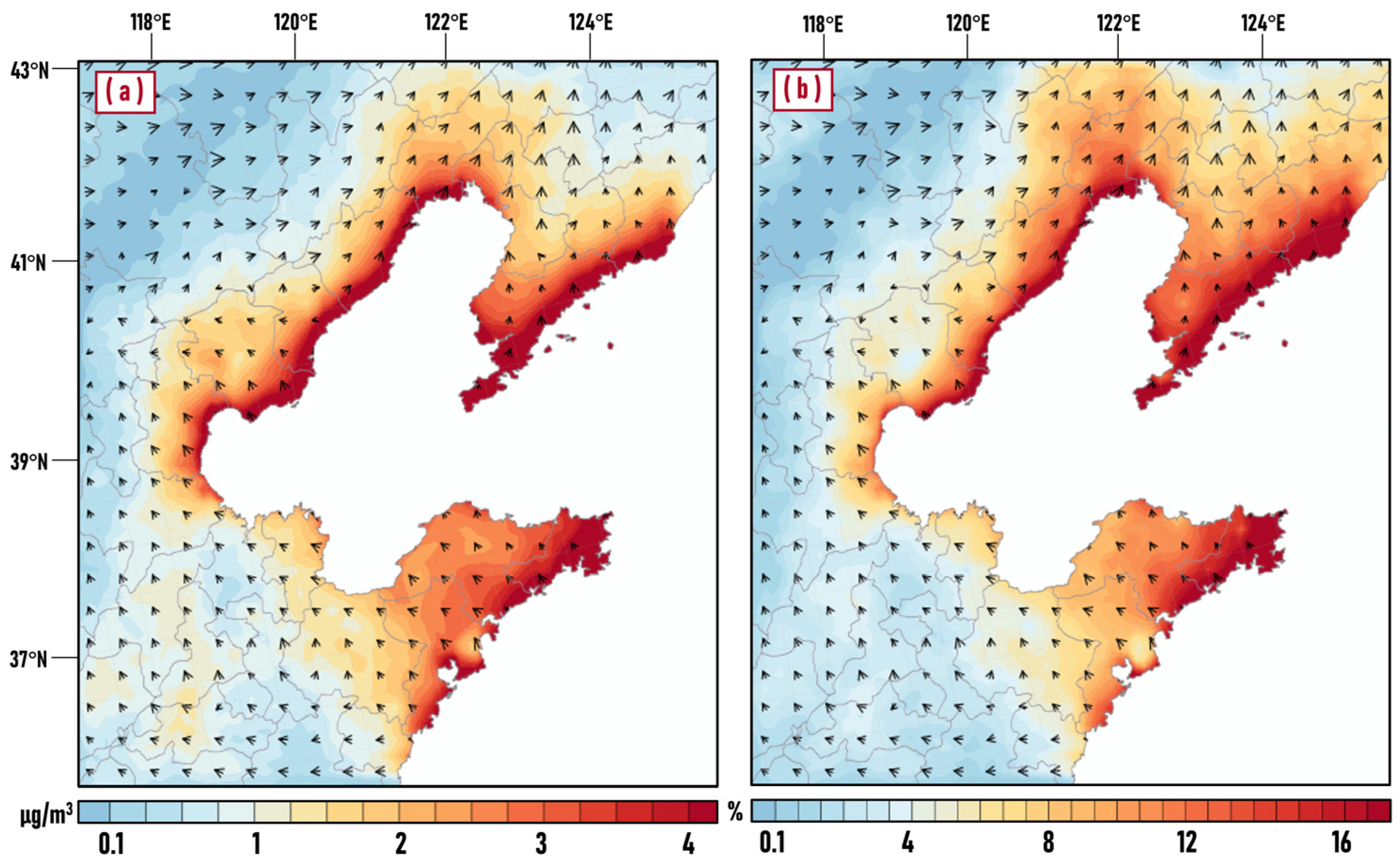
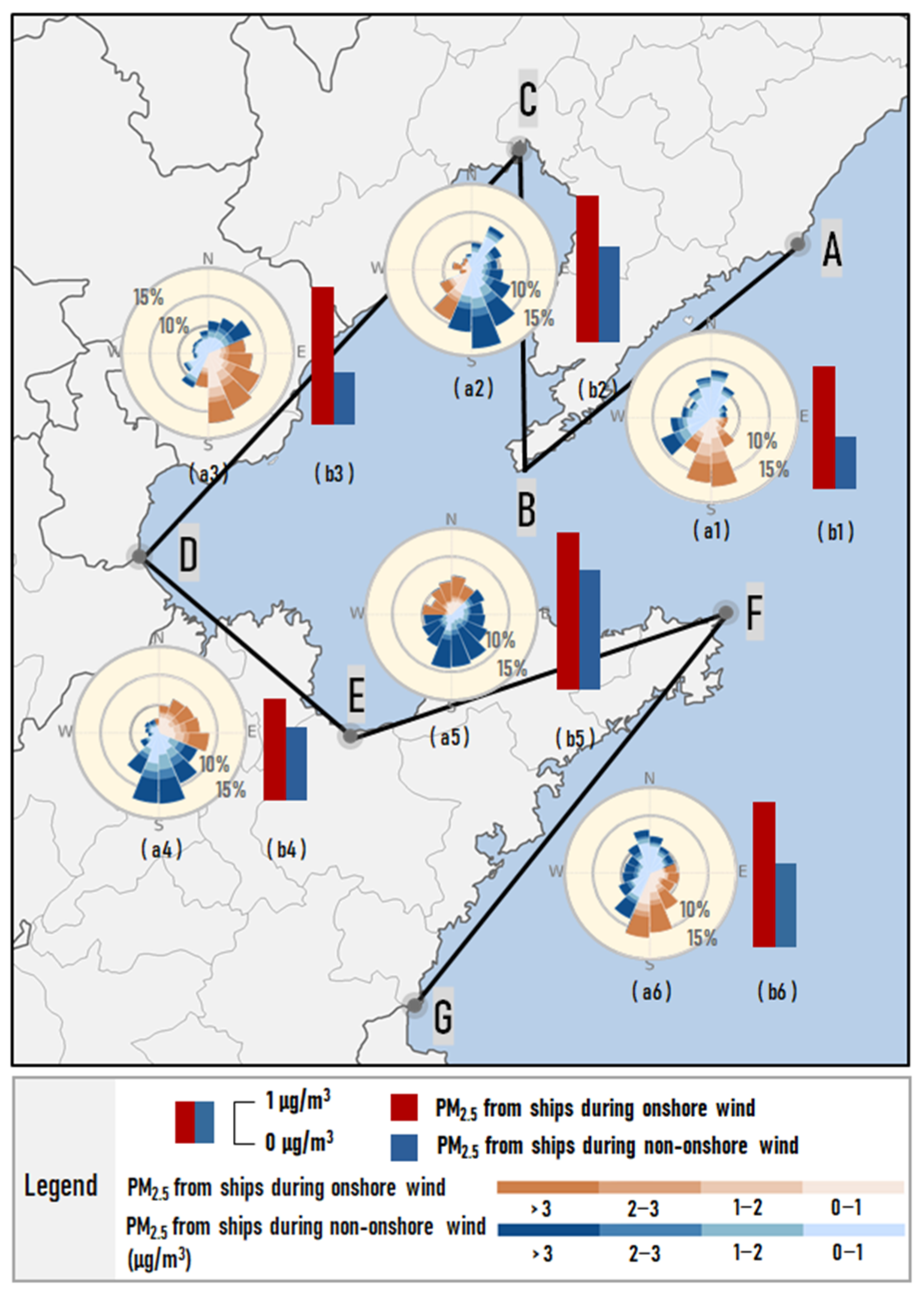
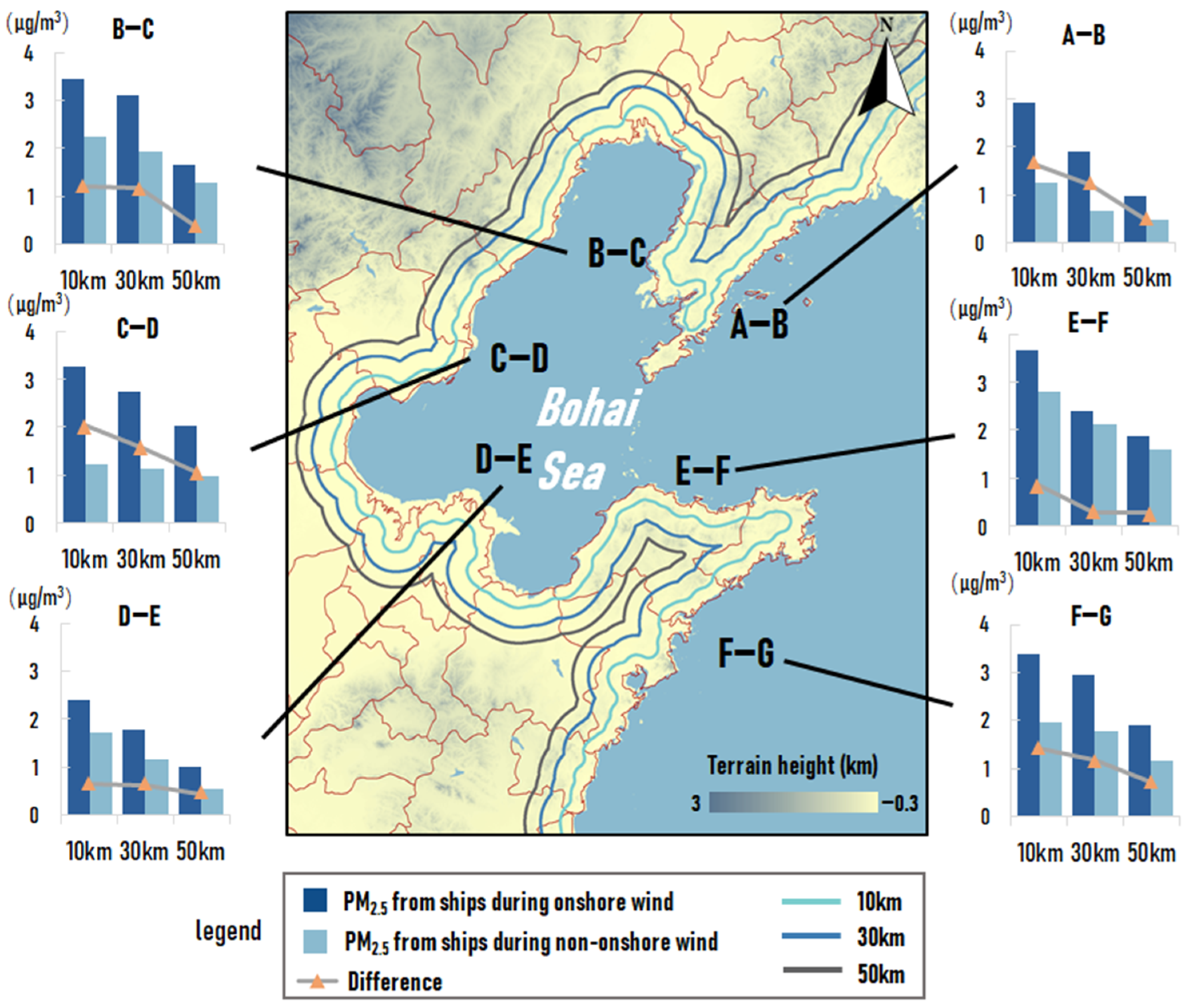


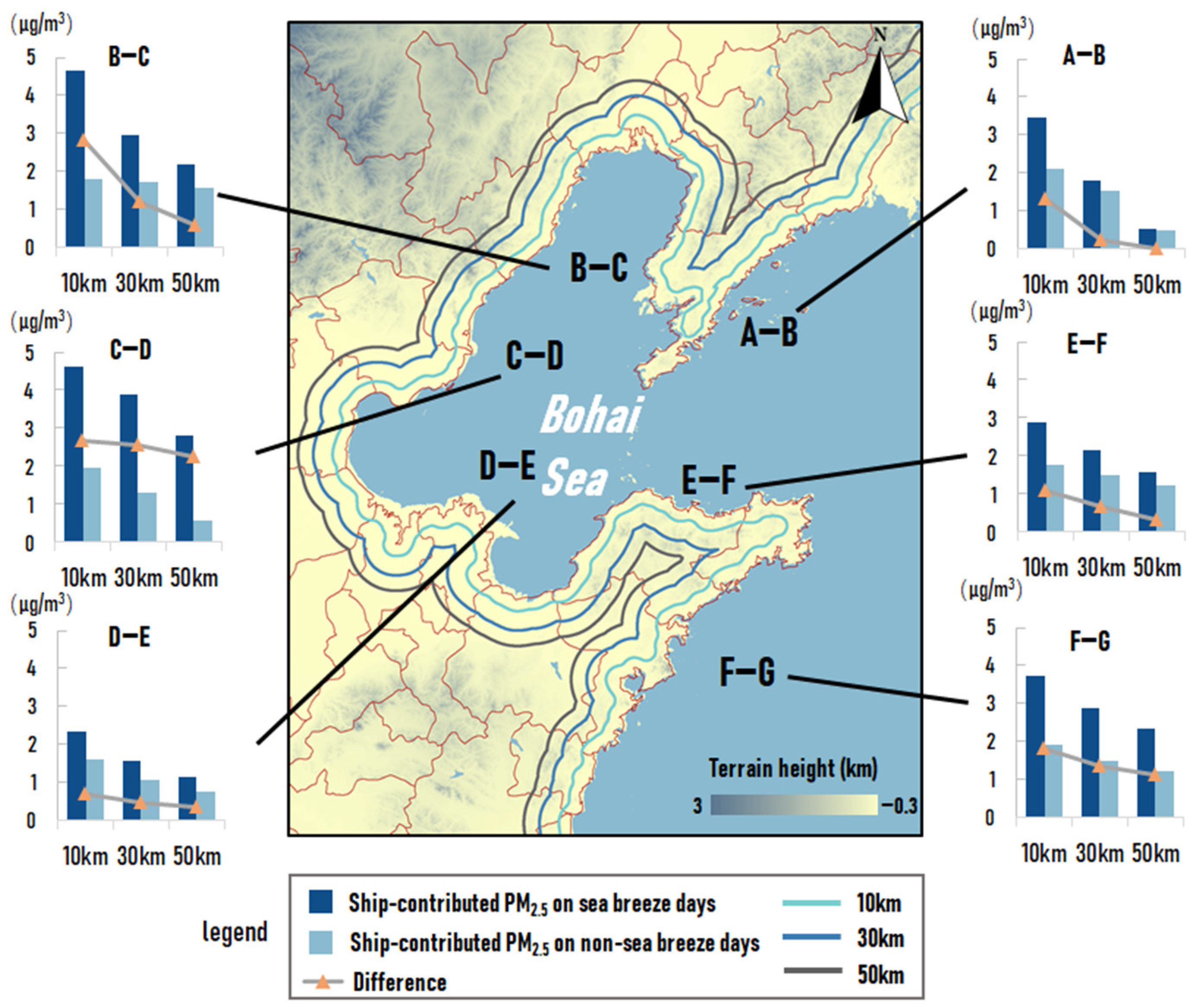
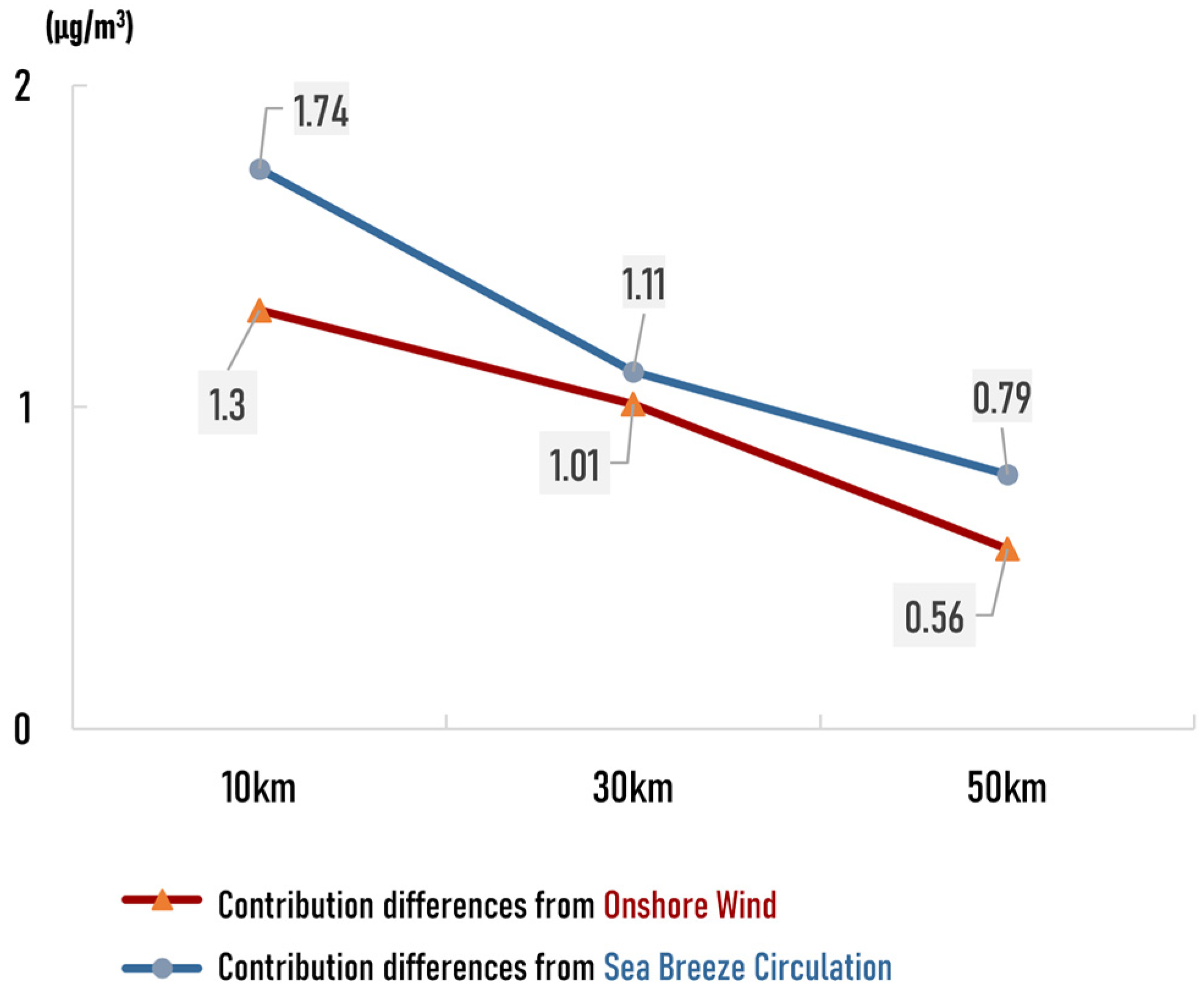
| Chemical and Pysics Options | Schemes | Reference | |
|---|---|---|---|
| Chemical Schemes | Gas-phase | The Regional Acid Deposition Model version 2 (RMD2) | Stockwell et al. [49] |
| Aerosol | The Modal Aerosol Dynamics Model for Europe (MADE/SORGAM) | Ackermann et al., 1998; Schell et al. [50] | |
| Physics Schemes | Planetary Boundary layer | Yonsei University (YSU) | Hong et al. [51] |
| Long-wave Radiation | Eta Geophysical Fluid Dynamics Laboratory (GFDL) | Fels and Schwarzkopf [52] | |
| Shortwave Radiation | Goddard | Chou and Suarez [53] | |
| Microphysics | Purdue Lin | Lin et al. [54] | |
| Land Surface Model | Noah | Ek et al. [55] | |
| Species | Month | MB 1 | MAE 2 | NMB 3 (%) | NME 4 (%) | R 5 |
|---|---|---|---|---|---|---|
| T2 °C | April | −0.51 | 1.40 | −4.04 | 4.81 | 0.90 |
| May | −0.15 | 1.27 | −0.71 | 4.41 | 0.91 | |
| June | −0.29 | 0.96 | −1.33 | 4.04 | 0.89 | |
| July | 0.03 | 0.95 | −0.49 | 1.52 | 0.86 | |
| August | 0.12 | 0.66 | 0.47 | 2.67 | 0.91 | |
| September | 0.73 | 1.33 | 3.99 | 6.57 | 0.92 | |
| RH2 % | April | 0.81 | 9.52 | 0.29 | 5.53 | 0.83 |
| May | 1.27 | 7.34 | 0.64 | 8.38 | 0.86 | |
| June | 2.25 | 7.24 | 2.37 | 4.54 | 0.83 | |
| July | −0.19 | 7.95 | 6.74 | 12.38 | 0.85 | |
| August | 2.78 | 5.61 | 3.30 | 6.72 | 0.86 | |
| September | 1.30 | 5.22 | 1.56 | 6.87 | 0.87 | |
| WS10 m/s | April | 0.81 | 0.98 | 30.23 | 36.78 | 0.71 |
| May | 0.65 | 0.95 | 17.86 | 26.18 | 0.74 | |
| June | 0.42 | 0.90 | 2.17 | 22.86 | 0.73 | |
| July | 0.49 | 0.91 | 8.09 | 28.14 | 0.75 | |
| August | 0.88 | 0.99 | 10.12 | 26.52 | 0.73 | |
| September | 0.79 | 1.06 | 11.38 | 27.79 | 0.75 | |
| WD10 ° | April | 5.32 | 25.71 | 17.98 | 28.98 | 0.73 |
| May | 8.86 | 19.45 | 3.28 | 7.21 | 0.76 | |
| June | 14.79 | 21.96 | 5.60 | 8.32 | 0.76 | |
| July | 15.82 | 23.00 | 6.02 | 8.75 | 0.76 | |
| August | 6.31 | 15.26 | 2.31 | 5.60 | 0.77 | |
| September | 19.16 | 28.24 | 7.38 | 10.88 | 0.78 |
| Month | NMB (%) | NME (%) | MFB 1 (%) | MFE 2 (%) | R |
|---|---|---|---|---|---|
| April | −13.48 | 34.05 | −23.59 | 26.26 | 0.85 |
| May | −21.46 | 28.35 | −12.29 | 16.72 | 0.81 |
| June | −2.01 | 28.59 | −1.96 | 20.96 | 0.81 |
| July | −15.11 | 10.56 | −7.47 | 16.61 | 0.81 |
| August | 10.86 | 29.58 | 6.47 | 19.32 | 0.76 |
| September | 13.66 | 33.30 | 5.40 | 17.95 | 0.80 |
| Area | Onshore Wind Range |
|---|---|
| Section A-B | ENE-SSW 1 |
| Section B-C | SSW-NNW |
| Section C-D | ENE-SSW |
| Section D-E | NNW-ESE |
| Section E-F | W-NE |
| Section F-G | ENE-SSW |
Publisher’s Note: MDPI stays neutral with regard to jurisdictional claims in published maps and institutional affiliations. |
© 2022 by the authors. Licensee MDPI, Basel, Switzerland. This article is an open access article distributed under the terms and conditions of the Creative Commons Attribution (CC BY) license (https://creativecommons.org/licenses/by/4.0/).
Share and Cite
Ma, Y.; Chen, D.; Fu, X.; Shang, F.; Guo, X.; Lang, J.; Zhou, Y. Impact of Sea Breeze on the Transport of Ship Emissions: A Comprehensive Study in the Bohai Rim Region, China. Atmosphere 2022, 13, 1094. https://doi.org/10.3390/atmos13071094
Ma Y, Chen D, Fu X, Shang F, Guo X, Lang J, Zhou Y. Impact of Sea Breeze on the Transport of Ship Emissions: A Comprehensive Study in the Bohai Rim Region, China. Atmosphere. 2022; 13(7):1094. https://doi.org/10.3390/atmos13071094
Chicago/Turabian StyleMa, Yizhe, Dongsheng Chen, Xinyi Fu, Fang Shang, Xiurui Guo, Jianlei Lang, and Ying Zhou. 2022. "Impact of Sea Breeze on the Transport of Ship Emissions: A Comprehensive Study in the Bohai Rim Region, China" Atmosphere 13, no. 7: 1094. https://doi.org/10.3390/atmos13071094
APA StyleMa, Y., Chen, D., Fu, X., Shang, F., Guo, X., Lang, J., & Zhou, Y. (2022). Impact of Sea Breeze on the Transport of Ship Emissions: A Comprehensive Study in the Bohai Rim Region, China. Atmosphere, 13(7), 1094. https://doi.org/10.3390/atmos13071094








